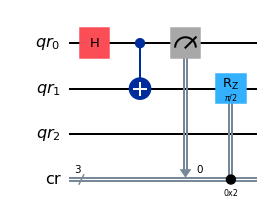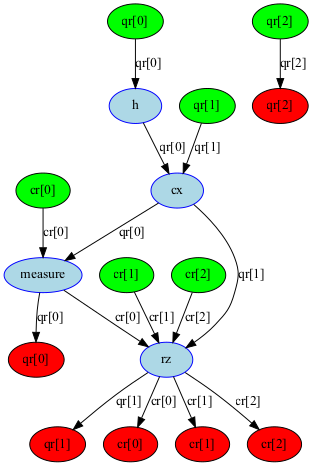Write a custom transpiler pass
Package versions
The code on this page was developed using the following requirements. We recommend using these versions or newer.
qiskit[all]~=1.2.4
qiskit-aer~=0.15.1
qiskit-ibm-runtime~=0.31.0
qiskit-serverless~=0.17.1
qiskit-ibm-catalog~=0.1
The Qiskit SDK lets you create custom transpilation passes and run them in the PassManager object or add them to a StagedPassManager. Here we will demonstrate how to write a transpiler pass, focusing on building a pass that performs Pauli twirling on the noisy quantum gates in a quantum circuit. This example uses the DAG, which is the object manipulated by the TransformationPass type of pass.
Background: DAG representation
Background: DAG representation
Before building a pass, it is important to introduce the internal representation of quantum circuits in Qiskit, the directed acyclic graph (DAG) (see this tutorial for an overview). To follow these steps, install the graphviz library for the DAG plotting functions.
In Qiskit, within the transpilation stages, circuits are represented using a DAG. In general, a DAG is composed of vertices (also known as "nodes") and directed edges that connect pairs of vertices in a particular orientation. This representation is stored using qiskit.dagcircuit.DAGCircuit objects that are composed of invididual DagNode objects. The advantage of this representation over a pure list of gates (that is, a netlist) is that the flow of information between operations is explicit, making it easier to make transformation decisions.
This example illustrates the DAG by creating a simple circuit that prepares a Bell state and applies an rotation, depending on the measurement outcome.
from qiskit import QuantumRegister, ClassicalRegister, QuantumCircuit
import numpy as np
qr = QuantumRegister(3, 'qr')
cr = ClassicalRegister(3, 'cr')
qc = QuantumCircuit(qr, cr)
qc.h(qr[0])
qc.cx(qr[0], qr[1])
qc.measure(qr[0], cr[0])
qc.rz(np.pi/2, qr[1]).c_if(cr, 2)
qc.draw(output='mpl')

Use the qiskit.tools.visualization.dag_drawer() function to view this circuit's DAG. There are three kinds of graph nodes: qubit/clbit nodes (green), operation nodes (blue), and output nodes (red). Each edge indicates data flow (or dependency) between two nodes.
from qiskit.converters import circuit_to_dag
from qiskit.tools.visualization import dag_drawer
dag = circuit_to_dag(qc)
dag_drawer(dag)
Transpiler passes
Transpiler passes are classified either as an AnalysisPass or a TransformationPass. Passes in general work with the DAG and the property_set, a dictionary-like object for storing properties determined by analysis passes. Analysis passes work with both the DAG and its property_set. They cannot modify the DAG, but can modify the property_set. This contrasts with transformation passes, which do modify the DAG, and can read (but not write to) property_set. For example, transformation passes translate a circuit to its ISA or perform routing passes to insert SWAP gates where needed.
Create a PauliTwirl transpiler pass
The following example constructs a transpiler pass that adds Pauli twirls. Pauli twirling is an error suppression strategy that randomizes how qubits experience noisy channels, which we assume to be two-qubit gates in this example (because they are much more error-prone than single-qubit gates). The Pauli twirls do not affect the two-qubit gates' operation. They are chosen such that those applied before the two-qubit gate (to the left) are countered by those applied after the two-qubit gate (to the right). In this sense, the two-qubit operations are identical, but the way they are performed is different. One benefit of Pauli twirling is that it turns coherent errors into stochastic errors, which can be improved by averaging more.
Transpiler passes act on the DAG, so the important method to override is .run(), which takes the DAG as input. Initializing pairs of Paulis as shown preserves the operation of each two-qubit gate. This is done with the helper method build_twirl_set, which goes through each two-qubit Pauli (as obtained from pauli_basis(2)) and finds the other Pauli that preserves the operation.
From the DAG, use the op_nodes() method to return all of its nodes. The DAG can also be used to collect runs, which are sequences of nodes that run uninterrupted on a qubit. These can be collected as single-qubit runs with collect_1q_runs, two-qubit runs with collect_2q_runs, and runs of nodes where the instruction names are in a namelist with collect_runs. The DAGCircuit has many methods for searching and traversing a graph. One commonly used method is topological_op_nodes, which provides the nodes in a dependency ordering. Other methods such as bfs_successors are used primarily to determine how nodes interact with subsequent operations on a DAG.
In the example, we want to replace each node, representing an instruction, with a subcircuit built as a mini DAG. The mini DAG has a two-qubit quantum register added to it. Operations are added to the mini DAG by using apply_operation_back, which places the Instruction on the mini DAG's output (whereas apply_operation_front would place it on the mini DAG's input). The node is then substituted by the mini DAG by using substitute_node_with_dag, and the process continues over each instance of CXGate and ECRGate in the DAG (corresponding to the two-qubit basis gates on IBM® backends).
from qiskit.dagcircuit import DAGCircuit
from qiskit.circuit import QuantumCircuit, QuantumRegister, Gate
from qiskit.circuit.library import CXGate, ECRGate
from qiskit.transpiler import PassManager
from qiskit.transpiler.basepasses import TransformationPass
from qiskit.quantum_info import Operator, pauli_basis
import numpy as np
from typing import Iterable, Optionalclass PauliTwirl(TransformationPass):
"""Add Pauli twirls to two-qubit gates."""
def __init__(
self,
gates_to_twirl: Optional[Iterable[Gate]] = None,
):
"""
Args:
gates_to_twirl: Names of gates to twirl. The default behavior is to twirl all
two-qubit basis gates, `cx` and `ecr` for IBM backends.
"""
if gates_to_twirl is None:
gates_to_twirl = [CXGate(), ECRGate()]
self.gates_to_twirl = gates_to_twirl
self.build_twirl_set()
super().__init__()
def build_twirl_set(self):
"""
Build a set of Paulis to twirl for each gate and store internally as .twirl_set.
"""
self.twirl_set = {}
# iterate through gates to be twirled
for twirl_gate in self.gates_to_twirl:
twirl_list = []
# iterate through Paulis on left of gate to twirl
for pauli_left in pauli_basis(2):
# iterate through Paulis on right of gate to twirl
for pauli_right in pauli_basis(2):
# save pairs that produce identical operation as gate to twirl
if (Operator(pauli_left) @ Operator(twirl_gate)).equiv(
Operator(twirl_gate) @ pauli_right
):
twirl_list.append((pauli_left, pauli_right))
self.twirl_set[twirl_gate.name] = twirl_list
def run(
self,
dag: DAGCircuit,
) -> DAGCircuit:
# collect all nodes in DAG and proceed if it is to be twirled
twirling_gate_classes = tuple(
gate.base_class for gate in self.gates_to_twirl
)
for node in dag.op_nodes():
if not isinstance(node.op, twirling_gate_classes):
continue
# random integer to select Pauli twirl pair
pauli_index = np.random.randint(
0, len(self.twirl_set[node.op.name])
)
twirl_pair = self.twirl_set[node.op.name][pauli_index]
# instantiate mini_dag and attach quantum register
mini_dag = DAGCircuit()
register = QuantumRegister(2)
mini_dag.add_qreg(register)
# apply left Pauli, gate to twirl, and right Pauli to empty mini-DAG
mini_dag.apply_operation_back(
twirl_pair[0].to_instruction(), [register[0], register[1]]
)
mini_dag.apply_operation_back(node.op, [register[0], register[1]])
mini_dag.apply_operation_back(
twirl_pair[1].to_instruction(), [register[0], register[1]]
)
# substitute gate to twirl node with twirling mini-DAG
dag.substitute_node_with_dag(node, mini_dag)
return dagUse the PauliTwirl transpiler pass
The following code uses the pass created above to transpile a circuit. Consider a simple circuit with cxs and ecrs.
qc = QuantumCircuit(3)
qc.cx(0, 1)
qc.ecr(1, 2)
qc.ecr(1, 0)
qc.cx(2, 1)
qc.draw("mpl")Output:
To apply the custom pass, build a pass manager using the PauliTwirl pass and run it on 50 circuits.
pm = PassManager([PauliTwirl()])
twirled_qcs = [pm.run(qc) for _ in range(50)]Each two-qubit gate is now sandwiched between two Paulis.
twirled_qcs[-1].draw("mpl")Output:
The operators are the same if Operator from qiskit.quantum_info is used:
np.all([Operator(twirled_qc).equiv(qc) for twirled_qc in twirled_qcs])Output:
True
Next steps
- To learn how to use the
generate_preset_passmanagerfunction instead of writing your own passes, start with the Transpilation default settings and configuration options topic. - Try the Submit transpiled circuits tutorial.
- Review the Transpile API documentation.